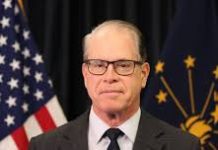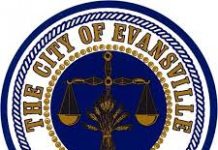Indiana’s Black Community Is More At Risk For COVID-19 Yet Hesitant To Get The Vaccine
(This is part of a series about how Black, Hispanic/Latinx and Asian Hoosiers have responded to the COVID-19 vaccine. A Spanish language version of the Hispanic/Latinx story can be found here. Look for a graphic breaking down the numbers for all the groups here.)
By Carolina Puga Mendoza and Alexa Shrake
TheStatehouseFile.comÂ
INDIANAPOLIS—As eligibility for the COVID-19 vaccine opens up for all Hoosiers, those who identify as white and Asian are taking the lead in getting vaccinated while some minority groups are falling behind.
According to the state’s vaccine dashboard, 6% of available vaccines have been claimed by those who identify as Black in Indiana. Data from the Kaiser Family Foundation shows just 22% of those who are Black have been vaccinated in the state.
While COVID-19 has affected all of the nation regardless of race, Black people are being hospitalized almost three times more than white people, according to the Centers for Disease Control and Prevention.Â
To get more people to vaccinate, Indiana has been seeking community leaders to help educate about the COVID-19 vaccine. To accomplish that, the state is using $9 million from federal grants to help minority groups by having translators and advertisements.
However, problems built up in the community due to years of systemic racism and inequality in the health system have left Black people skeptical of the process, and they are experiencing other roadblocks.

What are the problems?Â
Individuals within the African-American community are at a higher risk of getting COVID-19 than other groups, according to the CDC. Income, education, health care access and mistrust are just a few of the factors that prevent minority communities from getting the vaccine and that cause them to get sicker.
Economic disparity plays a big role in why Black Hoosiers are being vaccinated at a lower rate. In 2019, for example, the national poverty rate for Black households stood at 18.7% compared to 7.3% for white households, according to the Economic Policy Institute.
The economic difference can be seen in the lack of transportation in predominantly Black neighborhoods or internet and phone service that are needed to schedule and make appointments.
Dr. Roland Walker, a Gary pediatrician, spoke at the governor’s COVID-19 press conference in March about the necessity of local leaders to convince members of the Black community to get vaccinated.
Walker said he has seen pharmacies go to suburban communities by highway exits rather than in urban communities, making it hard to get to vaccination centers.
“Some of these vaccine programs are through some of the big chain pharmacies, but these pharmacies don’t come into the inner city anymore,†Walker said.
Why the hesitancy?
The reluctance to get the vaccine administered also can be tied to the health care system’s long history of using Black people for testing and research, often against their wills or without their knowledge (the Tuskegee experiment is just one example), leading to mistrust that has caused some vaccine hesitancy.
In addition, Black people face health care discrimination and are less likely to access health care services.
According to Walker, patience and time are needed to convince them to get the COVID-19 vaccine.
“You got to understand that people are fighting hundreds of years of mistrust and misuse and abuse, and they’re trying to get past that,†Walker said.
According to the National Foundation for Infectious Diseases, 49% of Black people plan to get the COVID-19 vaccine, but 31% are unsure of getting it.
What’s the solution?Â
Indiana officials are reaching out to community leaders to spread information and reassurance about the COVID-19 vaccine.
Rep. Robin Shackleford, D-Indianapolis, chair of the Indiana Black Legislative Caucus, said the IBLC is trying to reach out to the Black community to encourage them to get the vaccine. The state is trying to provide resources through churches and community groups.
Shackleford said she received her vaccine on March 5 at the Indianapolis Motor Speedway.
“I would just encourage the minority community to go get [the vaccine]. I think for the challenges and fear that they have, that would override like if you did get COVID and have the possibility of death.†Shackleford said. “I highly recommend getting the vaccine.â€
Similar efforts include the Indianapolis Urban League, a social service and civil rights organization, opening its facilities as a vaccination site in Northwest Indianapolis.
Anthony Mason, CEO of the IUL, said that hosting COVID-19 vaccinations at the IUL will help people trust the process and be more willing to get the shot. He understands the hesitancy and reluctance of getting the vaccine due to the history of racism in the health system.
“As we progress towards vaccines being made available to the community, you know, we have a strong interest in being a part of that process, whether it was as simple as encouraging and promoting vaccination or … us hosting vaccinations here to help people to maybe trust more in the process,†Mason said.
The organization has opened its doors beyond COVID-19 information to include COVID-19 testing, flu shots, voter information, census information and more.
Indianapolis Mayor Joe Hogsett announced the beginning of a COVID-19 Community Ambassador program to keep Hoosiers updated on vaccine information. The program is made possible through a partnership with the Office of Public Health and Safety and the Marion County Public Health Department.
“Communication from trusted leaders at all levels is critical to ensuring our residents of all backgrounds feel safe and confident in receiving a potentially life-saving vaccine,†Hogsett said. “This effort allows the power of connections to be at the forefront of disseminating critical vaccine information. Neighbor to neighbor, we can dispel myths and remove barriers to get our city on a healthier path.â€
FOOTNOTE: Carolina Puga Mendoza and Alexa Shrake are reporters for TheStatehouseFile.com, a news website powered by Franklin College journalism students.
This is part of a series about how Black, Hispanic/Latinx and Asian Hoosiers have responded to the COVID-19 vaccine. A Spanish-language version of the Hispanic/Latinx story can be found here. Look for a graphic breaking down the numbers for all the groups here.






